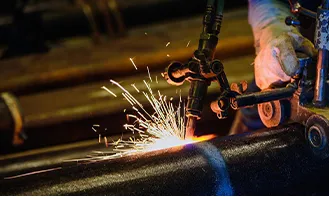Understanding the Basics of Welding Electrodes and Their Applications
An Overview of Welding Stick The Backbone of Welding Techniques
Welding is an essential process in various industries, ranging from construction to automotive manufacturing. At the heart of many welding techniques lies the welding stick, also known as an electrode. This seemingly simple tool plays a critical role in ensuring strong, durable welds, making it a fundamental component of the welding process.
What is a Welding Stick?
A welding stick is a metal rod coated with a material that aids in the welding process. It serves a dual purpose providing the filler material that fuses with the base metals being joined and serving as an electrode to conduct electricity. The welding stick is essential in processes such as Shielded Metal Arc Welding (SMAW), commonly known as stick welding. Stick welding is one of the most versatile methods, capable of welding various materials, including steel, stainless steel, and cast iron.
Components of a Welding Stick
Welding sticks come in various sizes, types, and compositions, tailored for specific applications. The core of a welding stick is typically made of mild steel, while the coating consists of various materials—ranging from clay to calcium and sodium—that protect the molten weld pool from contamination by atmospheric gases. The characteristics of the coating also influence the arc stability, penetration, and the overall quality of the weld.
Types of Welding Sticks
There are several types of welding sticks, categorized primarily by their applications and coatings. Here are some of the most common types
1. E6010 This is a cellulosic electrode, ideal for welding in various positions. It produces deep penetration and is commonly used for pipe welding and maintenance work.
2. E6011 Similar to E6010, this electrode can be used on both AC and DC current, making it versatile for different power sources. It provides a stable arc and is good for general purpose welding.
welding stick

3. E6013 This type is often used for light structural work and is easier to use than E6010 and E6011. It produces less spatter and is favored for appearance.
4. E7018 Known for producing high-quality welds, E7018 electrodes are low-hydrogen rods suitable for critical applications. They are often used in structural steel welding where strength and toughness are paramount.
Advantages of Using Welding Sticks
One of the primary advantages of welding with sticks is the simplicity and portability of stick welding equipment. Unlike MIG or TIG welding, which may require gas and advanced machinery, stick welding requires only a power source and the welding stick. This makes it particularly advantageous in remote locations where transportation of equipment and materials is challenging.
Moreover, welding sticks are cost-effective. They are widely available and do not require the purchase of gas cylinders or complicated feed systems. This affordability makes stick welding an accessible option for small businesses and DIY enthusiasts.
Challenges in Stick Welding
Despite its numerous advantages, stick welding does come with challenges. One of the most significant issues is the requirement for a skilled operator. Achieving a clean and strong weld necessitates control over variables such as travel speed, angle, and heat settings. Additionally, the nature of stick welding can lead to slag deposits that must be cleaned from the weld joint afterwards.
Another challenge is the potential for welding issues like arc blow, which can occur due to magnetic fields affecting the arc’s stability. Proper training and experience are essential for overcoming these issues, ensuring that the welder can adjust techniques as necessary.
Conclusion
In the diverse landscape of welding, the welding stick remains a vital player. Its versatility, accessibility, and effectiveness make it an indispensable tool for welders across various industries. Whether you are engaged in heavy-duty manufacturing or small-scale repairs, understanding and utilizing the right welding stick can lead to successful outcomes. With proper training and practice, welders can master the art of stick welding, contributing to the continued growth and innovation within the welding field. As technology evolves, it's likely that new advancements in welding stick materials and designs will further enhance the quality and ease of welding processes, keeping this traditional method relevant in a modernized industrial landscape.
-
Best MIG Welding No Gas Flux Core Solution – Easy, Portable & Clean WeldingNewsJul.08,2025
-
7018 Welding Rod 3/16 - High Strength, Low Hydrogen Electrodes Wholesale 3/32 Welding Rod 7018 Suppliers & China 7018 AC Welding Rod FactoryNewsJul.08,2025
-
High Quality MIG Aluminium Welding Wire - Wholesale Factory Prices from China SuppliersNewsJul.07,2025
-
High-Quality Gasless Aluminum Welding Wire China Gasless Aluminum MIG Wire SupplierNewsJul.07,2025
-
High Quality Ordinary Welding Rod for Pipes – Reliable China Welding Rod 7016 SupplierNewsJul.06,2025
-
Welding Wire 0.9 mm ER70S-6 Supplier Wholesale Manufacturers & FactoriesNewsJul.06,2025


